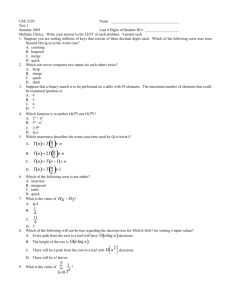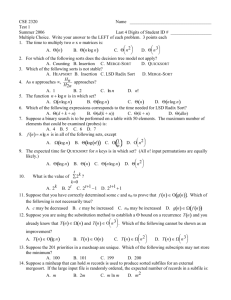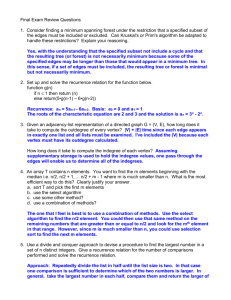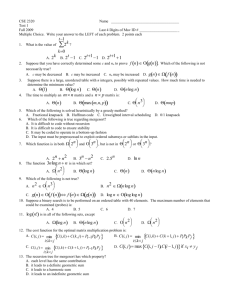fall04Z
advertisement
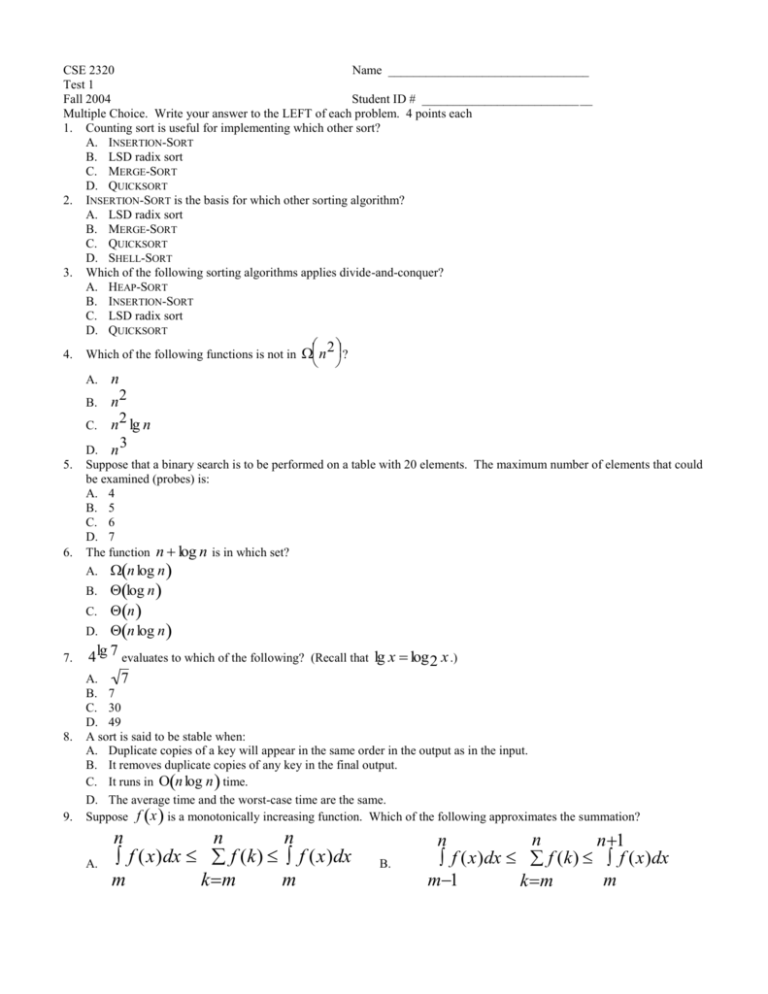
CSE 2320 Name ________________________________ Test 1 Fall 2004 Student ID # ___________________________ Multiple Choice. Write your answer to the LEFT of each problem. 4 points each 1. Counting sort is useful for implementing which other sort? A. INSERTION-SORT B. LSD radix sort C. MERGE-SORT D. QUICKSORT 2. INSERTION-SORT is the basis for which other sorting algorithm? A. LSD radix sort B. MERGE-SORT C. QUICKSORT D. SHELL-SORT 3. Which of the following sorting algorithms applies divide-and-conquer? A. HEAP-SORT B. INSERTION-SORT C. LSD radix sort D. QUICKSORT 4. 2 Which of the following functions is not in n ? A. B. 5. 6. C. n n2 n2 lg n n3 D. Suppose that a binary search is to be performed on a table with 20 elements. The maximum number of elements that could be examined (probes) is: A. 4 B. 5 C. 6 D. 7 The function n log n is in which set? n log n B. log n C. n D. n log n 7. 4lg 7 evaluates to which of the following? (Recall that lg x log 2 x .) A. 7 B. 7 A. 8. 9. C. 30 D. 49 A sort is said to be stable when: A. Duplicate copies of a key will appear in the same order in the output as in the input. B. It removes duplicate copies of any key in the final output. C. It runs in n log n time. D. The average time and the worst-case time are the same. Suppose f x is a monotonically increasing function. Which of the following approximates the summation? A. n n n f (x)dx f (k) f (x)dx m m km B. n n n1 f (x)dx f (k) f (x)dx m1 m km C. 10. n n1 n1 f (x)dx f (k) f (x)dx m1 m1 km Which of the following will not be true regarding the decision tree for QUICKSORT for sorting n input values? A. Every path from the root to a leaf will have n log n decisions. B. The height of the tree is n log n . D. n n1 n f (x)dx f (k) f (x)dx m m1 km 2 C. There will be a path from the root to a leaf with n decisions. D. There will be n! leaves. Long Answer 1. Prove that if f (n) g(n) then gn f n. 10 points 2. List the four phases in a counting sort andthe time for each. 5 points 2 2 3. Use the substitution method to show that T n 2T n n is in n 15 points 2 2 2 4. Use the recursion-tree method to show that T n 2T n n is in n 15 points 2 5. Demonstrate PARTITION on the following array. 10 points 7 5 6 8 9 0 1 2 3 4 6. Give two ways that heaps are relevant to mergesort with external devices. 5 points CSE 2320 Name________________________________ Test 2 Fall 2004 Student ID # ___________________________ Multiple Choice. Write the letter of your answer to the LEFT of each problem. 4 points each 1. The stack for rat-in-a-maze stores A. all positions that have walls B. maze positions that must be in the final path C. the current path being explored D. the shortest known path that leads to the cheese 2. In the example of recycling the elements of a list in O(1) time, which situation holds? A. Both lists are not circular B. Both lists are circular C. The garbage list is circular, the list to be recycled is not D. The list to be recycled is circular, the garbage list is not 3. The most accurate description of the time to perform a deletion in an unbalanced binary search tree with n keys and height h is: A. 1 log n C. n D. h B. 4. 5. 6. In which situation will a sentinel be inappropriate? A. Binary search for a key in an ordered table, to simplify and speed-up code B. Search for a key in an unordered table, to simplify and speed-up code C. Search for a key in an unordered linked list, to simplify and speed-up code D. Red-black tree, to simplify code Why is it common for a circular queue implementation to waste one table element? A. To avoid confusing an empty table with a full table B. To have a place to store the tail and head values C. To make sure the queue always has at least one element in use D. To perform some loops faster When evaluating a postfix expression, the stack contains A. Both operands and operators B. Both parentheses and operators C. Operands only D. Operators only The worst-case time to find the maximum key in a circular, doubly-linked list with n nodes in no particular order is: A. (1) B. (log n) C. (n log n) D. (n) 8. How should the successor of a node without a right child in an unbalanced binary search tree be found? A. Examine the ancestors of the node B. Go right, then proceed to the left C. Inorder traversal D. Preorder traversal 9. If POP is implemented as return stack[--SP], then PUSH of element X is implemented as: A. return stack[SP++] B. stack[SP++] = X C. stack[--SP] = X D. stack[++SP] = X 10. Suppose that only numbers in 1 . . . 1000 appear as keys in a binary search tree. While searching for 500, which of the following sequences of keys could not be examined? A. 10, 200, 300, 100, 500 B. 100, 1000, 200, 900, 300, 800, 400, 700, 500 C. 200, 300, 400, 700, 600, 500 D. 600, 100, 550, 540, 500 Long Answer 1. Identify the problems with the following attempt at constructing a red-black tree. (10 points) 7. 40 20 60 13 70 50 30 14 10 75 15 2. Consider the following hash table whose keys were stored by linear probing using h(key, i) = (key + i) % 13. 1 0 2 3 4 94 5 6 7 8 9 10 122 110 20 86 87 62 a. 3. Give the number of probes needed to find each of the seven stored keys (using linear probing). (7 points) 94 ______ 122 ______ 110 ______ 20 ______ 86 ______ 87 ______ 62 ______ b. Suppose 135 is to be stored (using linear probing). Which slot will be used? (3 points) Insert 35 into the given red-black tree. Be sure to indicate the cases that you used. (10 points) 40 60 20 10 30 80 50 70 4. 11 Insert 127 into the given red-black tree. Be sure to indicate the cases that you used. (10 points) 12 40 150 20 10 30 80 170 130 60 50 70 160 180 140 100 90 120 5. Consider the following hash table whose keys were stored by double hashing using h1(key) = key % 13 and h2(key) = 1 + (key % 12). 0 a. 1 2 3 4 5 6 120 186 187 162 7 8 9 122 110 10 11 12 194 Give the number of probes needed to find each of the seven stored keys (using double hashing). (7 points) 120 ______ 186 ______ 187 ______ 162 ______ 122 ______ 110 ______ 194 ______ b. Suppose 135 is to be inserted (using double hashing). Which slot will be used? (3 points) 6. Suppose that 1000 elements are stored in a hash structure with 100 slots that uses chaining to handle collisions. a. Give the expected probes for processing a hit. (5 points) b. Give the expected probes for processing a miss. (5 points) CSE 2320 Name ________________________________ Test 3 Fall 2004 Student ID # ___________________________ Multiple Choice. Write the letter of your answer to the LEFT of each problem. 3 points each 1. Which of the following is true about any cut for an instance of the network flow problem? A. The capacity is a lower bound on the maximum flow. B. The capacity is an upper bound on the maximum flow. C. The capacity is equal to the maximum flow. D. The cut was found by a depth-first search on the original input network. 2. Which of the following never uses a heap? A. Dijkstra’s algorithm B. Huffman code construction C. Longest common subsequence construction D. Prim’s algorithm 3. The main disadvantage of compressed adjacency lists is: A. Directed graphs may not be represented B. It is difficult to change the graph C. They waste space D. Undirected graphs may not be represented 4. The time to extract the LCS (for sequences of lengths m and n) after filling in the dynamic programming matrix is: A. (n) B. (m + n) C. (n log n) D. (mn) 5. When a graph is dense, the best way to find the shortest path to each vertex from a common source vertex is: A. Dijkstra’s algorithm using heap B. Dijkstra’s algorithm using T-table C. Floyd-Warshall algorithm D. Warshall’s algorithm 6. If the choice of the augmenting path is arbitrary (Ford-Fulkerson), an edge could be critical this number of times: A. E B. V C. (V-2)/2 D. depends on the maximum capacity appearing in the network 7. During depth-first search on a directed graph, a cycle is indicated by which edge type? A. Back B. Cross C. Forward D. Tree 8. The fastest method for finding the diameter of a tree is to: A. Use breadth-first search. B. Use Dijkstra’s algorithm. C. Use the Floyd-Warshall algorithm. D. Use the Ford-Fulkerson algorithm. 9. Suppose a depth-first search is performed on an undirected graph. The graph is a free (i.e. unrooted) tree if: A. all edges are tree edges B. both C and D C. there are no restarts D. there are no back edges 10. The relationship of the net flow across a cut and the amount of flow from the source to the sink is: A. The amount of flow does not exceed the net flow. B. The net flow does not exceed the amount of flow. C. There is no relationship. D. They are equal. 11. Suppose that a depth-first search on a directed graph yields a path of tree edges from vertex X to vertex Y. If there is also an edge from X to Y, then its type will be: A. Back B. Cross C. Forward D. Tree 12. Suppose that a maximum bipartitie matching with k edges is found using Edmonds-Karp. Which of the following does not hold? A. All residual network capacities are zero or one. B. Every augmenting path uses three edges. C. The capacity of the minimum cut is k. D. There will be k + 1 breadth-first searches. 13. Which of the following is not true for the activity scheduling problem? A. The activities may have various durations. B. The greedy solution is a heuristic. C. There may be several optimal solutions. D. The goal is to maximize the number of activities. 14. The goal of the optimal matrix multiplication problem is to: A. Minimize the number of C(i,j) instances evaluated. B. Minimize the number of matrix multiplications. C. Minimize the number of scalar additions. D. Minimize the number of scalar multiplications. 15. The fractional knapsack problem may be solved optimally by a greedy method by taking a fraction of no more than this number of items. A. 0 B. 1 C. 2 D. 3 Long Answer 1. What are the entries in the T-table (for Prim’s algorithm) before and after moving the next vertex and edge into the minimum spanning tree? DO NOT COMPLETE THE ENTIRE MST!!! Edges already in the MST are the thick ones. 10 points. 0 2 7 1 20 18 2 8 9 1 3 5 17 7 11 15 4 12 16 6 5 8 6 13 19 4 2. 3 10 14 9 Perform depth-first search on the following graph, including start/finish times and edge types (T=tree, B=back, C=cross, F=forward.) Assume that the adjacency lists are ordered. Write your answer in the tables below. 10 points 7 3 0 5 2 4 6 1 9 8 3. Vertex Start Finish Edge Type Edge Type 0 __1_ ____ 0 1 ____ 6 9 ____ 1 ____ ____ 2 1 ____ 7 0 ____ 2 ____ ____ 2 5 ____ 7 3 ____ 3 ____ ____ 2 7 ____ 7 5 ____ 4 ____ ____ 3 4 ____ 8 1 ____ 5 ____ ____ 4 6 ____ 8 2 ____ 6 ____ ____ 5 3 ____ 8 6 ____ 7 ____ ____ 5 4 ____ 8 9 ____ 8 ____ ____ 5 6 ____ 9 ____ ____ 6 2 ____ Demonstrate the Floyd-Warshall algorithm, with successors, for the following graph. 15 points. 2 0 4 3 7 1 9 1 1 1 3 4 2 4. Give augmenting paths for determining a maximum flow and give a minimum cut for the following network. 0 is the source and 7 is the sink. 10 points. 1 1 0 5 4 5 4 2 1 2 3 2 2 3 5 1 7 1 3 2 6 5. S vertices: 0 T vertices: 7 Augmenting Paths and Contribution to Flow: Complete the following instance of the optimal matrix multiplication ordering problem, including the tree showing the optimal ordering. 10 points p[0]=8 p[1]=6 p[2]=4 p[3]=3 p[4]=5 p[5]=7 1 2 3 4 5 1 0 0 192 1 216 1 336 3 ??? ? 2 ------0 0 72 2 162 3 303 3 3 ------- ------0 0 60 3 189 3 4 ------- ------- ------0 0 105 4 5 ------- ------- ------- ------0 0
